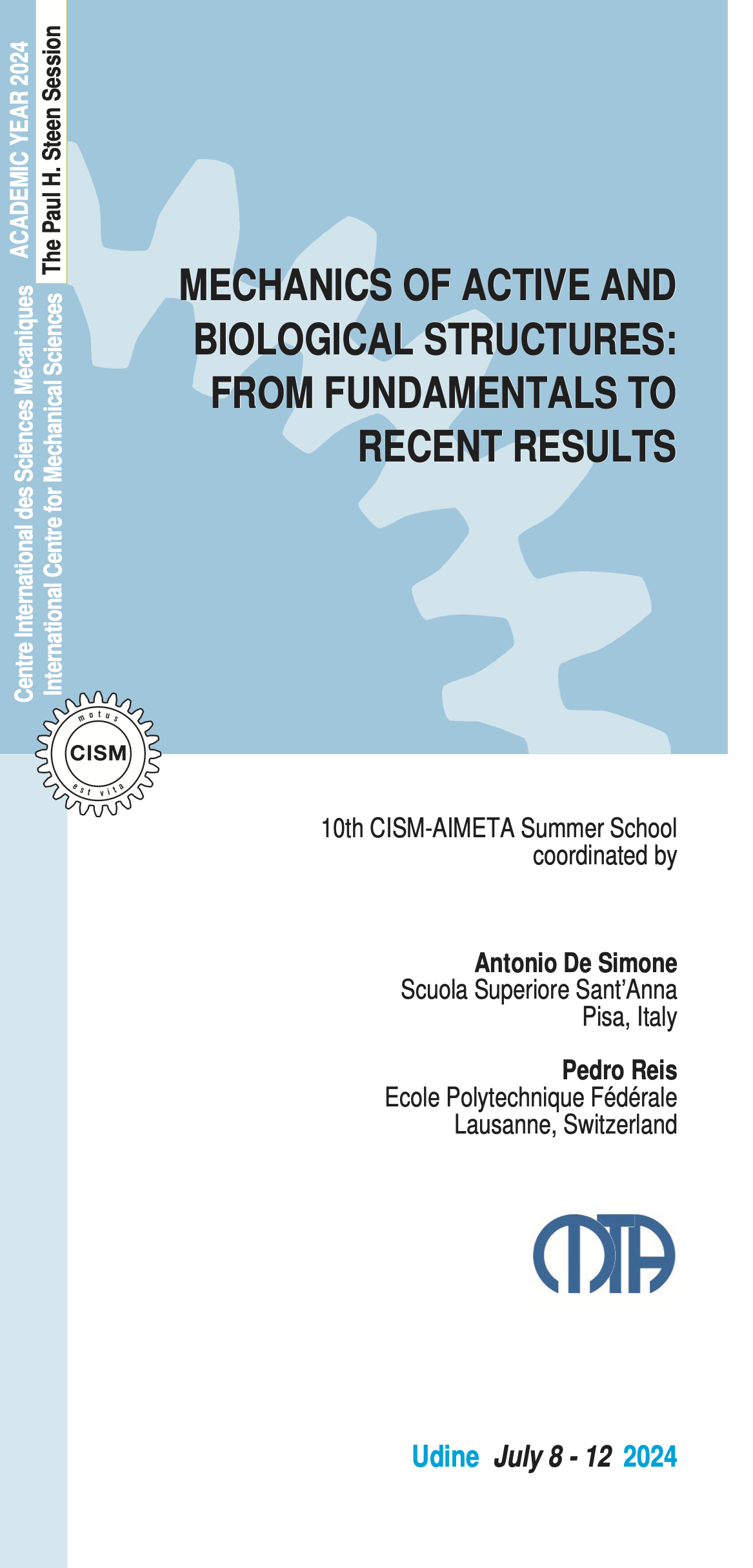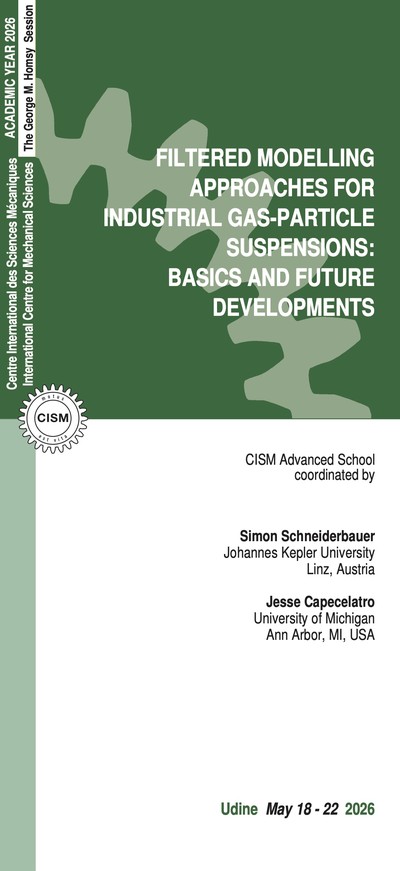The aim of this course is to provide participants with a fast track to frontier research of great contemporary interest starting from the revisiting of foundational aspects of the Mechanics of Solids and Structures. The course primarily targets beginning graduate students and young researchers who want to get an accelerated introduction to recent progress in the analysis of the response and failure of advanced materials and active systems, including biological ones.
A. De Simone and P. Reis will lecture on the mechanics of slender structures (rods, plates and shells), both active and passive, and applications to adaptive structures and to soft and bioinspired robotics. L. De Lorenzis and K. Ravi-Chandar will lecture on Fracture Mechanics, from modern experimental and theoretical foundations to recent advances on phase-field modeling and computation, and applications to biological tissues and porous media.
A. Goriely and Ellen Kuhl will lecture on the mechanobiology of growth and morphogenesis, and applications to quantitative modeling of the human brain.
The detailed plan of the lectures is the following.
Mechanics of 2d rods from Euler’s elastica to robotic arms and elephant trunks (ADS)
Kinematics and equilibrium of active planar rods in the large deformation regime; variational methods: the principle of virtual power and the finite element method.
Applications 1: shape control of structural systems with cables and tendons;
applications 2: shape control through active bending (snakes and elephant trunks);
applications 3: spontaneous oscillations in biological filaments and growing plant shoots.
Mechanics of 3d rods, plates and shells (PR)
Mechanics of rods – Kirchhoff’s rod theory: Kinematics & Equilibrium. Examples and Applications; Plates I: Pure bending deformation. Wrinkling; Plates II: Föppl-von Kárman (nonlinear) theory of plates. Plate buckling; Shells I: Linear pressure vessels, A primer on differential geometry, Dimensional reduction (3D-2D). Linear shell theory; Shells II: Nonlinear DMV shell theory. Shell buckling; Magneto-active Rods, Plates, and Shells.
Fracture Mechanics (KRC)
Griffith theory of fracture – the global approach; Engineering fracture mechanics – the local approach; Experimental fracture mechanics; Mixed-mode fracture – crack path selection; Elastic plastic fracture; Dynamic fracture.
Variational phase-field modeling of fracture (LDL)
The variational approach to brittle fracture; the phase-field regularization: main modeling components; crack nucleation vs. propagation, energy decomposition; computational aspects; phase-field modeling of ductile fracture; applications to anisotropic tissues and porous media.
The mathematics and mechanics of biological growth (AG)
The problem of growth; Growing in 1D: rods and filaments; Growing in 2D: membranes, plates, and shells; Growing in 3D: nonlinear elasticity and theory; Growing in 3D: applications (plants, arteries, and the brain); From 3D to 1D: dimensional reduction with applications.
Integrating mechanics and computation to understand the human brain (EK)
Introduction to Neuromechanics; Elasticity of the brain - Characterizing brain stiffness dead and alive; Growth of the brain; Understanding neurodevelopment; Damage of the brain - Traumatic brain injury and neurodegeneration; Machine learning and the brain; Integrating neuroimaging and mechanics.- Automated model discovery - Learning models for human brain.
D. Agostinelli, A. Lucantonio, G. Noselli, and A. DeSimone: Nutations in growing plant shoots: the role of elastic deformations due to gravity loading. J Mech Phys Solids 136, 103702 (2020).
G. Cicconofri and A. DeSimone: Snake-like locomotion through the analysis of a flexible robot model. Proc Roy Soc London A, 471 (2184), 20150054 (2015).
A. Goriely: The mathematics and mechanics of biological growth. Springer 2017.
B. Audoly and Y. Pomeau, Elasticity and geometry: from hair curls to the non-linear response of shells, Oxford University Press, 2010.
P.M. Reis, “A Perspective on the Revival of Structural (in)stability with Novel Opportunities for Function: from Buckliphobia to Buckliphilia” J. App. Mech., 82, 111001 (2015).
A. Lee, F. López Jiménez, J. Marthelot, J.W. Hutchinson, and P.M. Reis, “The geometric role of precisely engineered imperfections on the critical buckling load of spherical elastic shells” J. Appl. Mech., 83, 111005 (2016).
Budday S, Ovaert TC, Holzapfel GA, Steinmann P, Kuhl E. Fifty shades of brain: A review on the material testing and modeling of brain tissue. Arch Comp Meth Eng. 2020; 27:1187–1230.
K. Ravi-Chandar, (2023) Introduction to Fracture Mechanics, in Mechanics and Physics of Fracture, Editor: L. Ponson, CISM International Centre for Mechanical Sciences 608, https://doi.org/10.1007/978-3-031-18340-9_1.
L. De Lorenzis, T. Gerasimov (2020), Numerical Implementation of Phase-Field Models of Brittle Fracture. In: Modeling in Engineering Using Innovative Numerical Methods for Solids and Fluids, CISM – International Center for Mechanical Sciences – Courses and Lectures, 599: 75-101.
6 lectures on: Variational phase-field modeling of fracture.
5 lectures on: Mechanics of 2d rods from Euler’s elastica to robotic arms and elephant trunks.
6 lectures on: The mathematics and mechanics of biological growth.
6 lectures on: Integrating mechanics and computation to understand the human brain.
6 lectures on: Fracture Mechanics.
Replaced by Alain Goriely
6 lectures on: Mechanics of 3d rods, plates and shells.
ADMISSION AND ACCOMMODATION
The course is offered in a hybrid format, allowing participants the flexibility to attend either in person or remotely via the Microsoft Teams platform.
Limited spots are available for on-site attendance and will be allocated on a first-come, first-served basis.
The registration fees are:
- On-site participation: 600.00 Euro + VAT*
Includes a complimentary bag, five fixed menu buffet lunches, hot beverages, downloadable lecture notes.
Deadline for on-site application is June 8, 2024.
- Live Streaming Online Participation: 250.00 Euro + VAT*
Includes downloadable lecture notes.
Deadline for online application is June 26, 2024.
Application forms should be submitted online through the website: http://www.cism.it.
A confirmation message will be sent to accepted participants.
Upon request, a limited number of on-site participants can be accommodated at CISM Guest House at the price of 35 Euro per person/night (contact: foresteria@cism.it)
* where applicable (bank charges are not included) - Italian VAT is 22%.
CANCELLATION POLICY
Applicants may cancel their registration and receive a full refund by notifying the CISM Secretariat in writing (via email) no later than:
- June 8, 2024 for on-site participants (no refunds after the deadline);
- June 26, 2024 for online participants (no refunds after the deadline).
Cancellation requests received before these deadlines will be subject to a 50.00 Euro handling fee. Incorrect payments are also subject to a 50.00 Euro handling fee.
GRANTS
A limited number of participants from universities and research centres who do not receive support from their own institutions can request a waiver of the registration fee and/or free lodging.
Requests should be sent to the CISM Secretariat by May 8, 2024, along with the applicant's curriculum vitae and a letter of recommendation from the head of the department or a supervisor confirming that the institute cannot provide funding. Preference will be given to applicants from countries that sponsor CISM.





